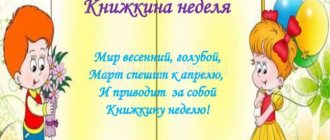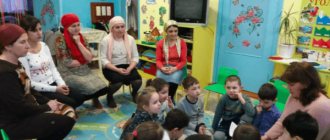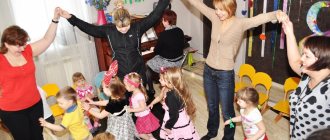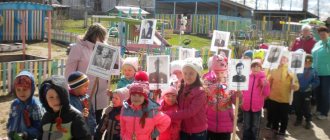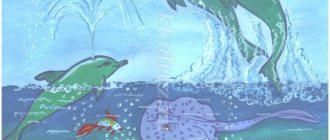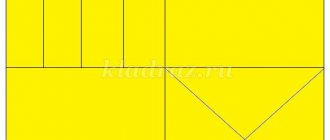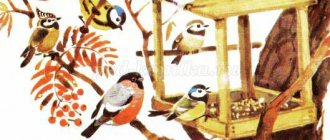“Book Week” in the senior group: planning
It is impossible to overestimate the impact that reading books has on literacy, replenishment of vocabulary, and expansion of a person’s horizons, especially in children at the preparatory stage of development.
“Book Week” at the preschool educational institution
For your information! It is easiest to develop an interest in new things in childhood, since children have the ability to vividly and sincerely experience, sympathize, rejoice, and be indignant, which manifests itself while reading a work of art.
Goals, objectives
The main goal of this project is to instill a love for reading books, teach children to respect them, and develop an interest in books through creative and educational activities.
During the implementation of this project, the following tasks are envisaged:
- To generate and maintain an interest in books and a love of reading, to cultivate a reader's taste and respect for books.
- Give children an idea of the types of books and literary genres.
- Familiarize children with all stages of book creation.
- To develop in children an understanding of the role of the writer, illustrator, and designer in the creation of a book.
- Explain to students the need and importance of libraries.
- Involve children, parents, and teachers in playing out stories from books.
Introducing kids to nature
Lexical topics
Every day of the calendar week it is planned to hold events (games, activities), presentations (speaking out abstracts and publishing notes in class) or thematic classes (communicating important information on a specific topic) on the following lexical topics:
- Monday. A walk around the native land. Acquaintance with nature through the works of writers Bianchi V.V., Prishvin M.M.
- Tuesday. Tanya, Yulechka, Petya and other heroes. Acquaintance with children's poetry through the works of Marshak S. Ya., Mikhalkov S. V., Agnia Barto, Tokmakova I. P., Mustai Karim.
- Wednesday. Travel to Buyan Island. Acquaintance with fairy tales and fables through the works of Pushkin A.S., Krylov I.A., Ushinsky K.D.
- Thursday. Walking around St. Petersburg. Acquaintance with the architecture, geography, life, climate of St. Petersburg through the poems of the poets A. A. Blok, Sasha Cherny.
- Friday. The Adventures of Bibigon. Acquaintance with the works of the writer Chukovsky K.I.
- Saturday. Dunno's friends. Acquaintance with the works of the writer N. N. Nosov.
Additional Information! Within each topic, children should be introduced to the biography and famous works of children's writers and poets, and a general description of their work should be given. Choose one of the plots in the works that most captivated the children, and role-play it with them.
Final event
The final event is that you should set aside time every day to make a book of your own composition and with drawings. At the end of Book Week, there will be an exhibition of books made by the children themselves.
Important! All events within the framework of Book Week must comply with federal state educational standards (FSES).
Methods of gender education for preschool children
MAGAZINE Preschooler.RF
BOOK WEEK IN KINDERGARTEN.Age of children: mixed age group.
Purpose and objectives of the event:
- Introduction to practice of various forms and methods of working with literary works that contribute to the familiarization of children with books for the development of cognitive, creative and emotional activity of children;
- Reveal knowledge of children's fairy tales through various types of games;
- Involve parents in joint creativity as part of Book Week ;
- Cultivate a desire for constant communication with the book and caring for it.
Preliminary work with children:
- Supplementing the book corner with new materials (books from mother’s childhood; books of different content, purpose, design; new books),
- Reading children's fairy tales, stories, memorizing poems,
- Selecting poems and preparing expressive reading for literary reading.
Duration:
Material:
- Portraits of children's writers,
- Portraits of writers - storytellers,
- "Tree of Mysteries"
- Cut-out pictures, cubes “My favorite fairy tales”
WORKING WITH TEACHERS
Get acquainted with the action plan.
Planning educational work for the implementation of “Children’s Book Week” .
Independently study the section of the sample program “From birth to school” “Introduction to fiction” .
WORKING WITH PARENTS
Re-read G.Kh.'s favorite fairy tales. Andersen and draw pictures for them.
WORK WITH CHILDREN
Diary of the week.
The first day
- Conducting a conversation on the topic “And the book has a name day!” – a message from the teacher about where and when “Children’s Book Week” was born;
- Meeting its creator;
- Congratulations to books (drawing cards for books);
Examination of children's books, illustrations, posters, portraits of children's writers
Second day
- Conversation attended by the work of Yu.M. Shcherbakova. "95th birthday"
- Participation in the regional event “Shcherbakov Readings”
Examination of children's books, illustrations, posters, portraits of children's writers
Day three
- Poetry hour “Kaleidoscope of Poems” - a competition for the best reading of your favorite poems;
- Journey through the exhibition: “Books – celebrants of anniversaries”, “Writers – celebrants of anniversaries”,
- Repair of “sick” books in the book corner “Knizhkina Hospital”.
- Review of children's periodicals.
Day four
- Excursion to the village library. A journey through the exhibition: “The Most Fabulous Writer” - an introduction to the work of G.Kh. Andersen.
- Thematic role-playing game “Library”
- Examination of children's books, illustrations, posters, portraits of children's writers
Day five
- Games - experiments with paper.
- Making bookmarks for books.
- Didactic games “Recognize a work from an excerpt” , “Recognize a fairy tale from an illustration” .
- participation in a reading competition (together with primary school)
- Examination of children's books, illustrations, posters, portraits of children's writers
Day six
- Continuation of the journey through the exhibitions: “The Most Fabulous Writer” - acquaintance with the work of G.Kh. Andersen.
- Literary holiday “I grow with the book . (Shared with the library)
Results: During the week, the children got acquainted with the history of the “Book Week”, its creator, the writers - celebrants of the day and their works, books - the celebrants of the day; completed creative work: “Congratulations to the book”, prepared drawings together with their parents; we learned how to “treat” and take care of books, visited the village library, and took part in a reading competition.
The children were left with good impressions, their vocabulary was enriched, and their horizons were broadened. The results of the thematic week are reflected in the photo report.
Methodological recommendations for parents, once again, convinced them that home reading or a bedtime story is an integral part of the child’s emotional and speech development.
In Rus', a book was compared to a staircase leading to the heights of education. “Book Week” in our group became a new step on this ladder.
| Next > |
Little book from old magazines
This is a very simple and interesting idea for a baby book that you can bring to life with your child. Let your child choose a topic, cut out pictures and place them on the page. This book is fun not only to read, but also to make, and then share with friends!
Photo: infourok.ru
You will need:
Old colorful books and magazines, scissors, paper, glue, pencils, thread and needle, tape.
How to do:
Decide on the size of the future baby book, the number of pages and the topic - for example, it could be animals and plants. Divide the cut-out illustrations into groups: wild animals, domestic animals, fish, birds, and so on.
For the cover, take thick sheets of cardboard, make the pages out of paper and sew them with thick strong thread. Inside you can leave inserts of entire magazine pages with educational information. This way, children will be able to learn more about those animals that were previously cut out and pasted on.
Appendix No. 1
"Announcement text"
Dear parents! Attention! Free lottery!
From March 25 to 28, Children's Book Week was held in the kindergarten. On April 3 and 4, our kindergarten will organize a lottery for parents of preschool educational institutions on the topic “Artworks and Human Rights”
Lottery rules.
- Participation in the lottery is free.
- All interested parents become participants.
- Participants answer questions by drawing a lottery ticket. Starting only from the first level - this is the question that is on the yellow ticket. After answering the first question, the participant takes the second and third tickets.
- You can answer only one question of each level, no more.
- The participant who answers correctly receives prizes. Namely: the first level receives a pen; second level – corner folder; third level - a book from the series “We read for ourselves, we read for mom.”
- A participant who answers the lottery questions incorrectly must name and write down on the sheet “Didn’t answer the question - write the title of the work” a favorite book or work that the child likes to listen to, leaf through, or look at.
Administration.
Thematic week “Book Week” Senior preschool age
Transcript
1 Thematic week “Book Week” Senior preschool age Final activities: Presentation: “The Magical World of Books.” — Exhibition of children's books “The Book is My Best Friend.” — Quiz based on N. Nosov’s fairy tales. — Literary project: “The Country of Chukokkala” To introduce preschool children to highly artistic literature. To develop an interest in books and children’s reading, to acquire a stock of literary artistic impressions and listener experience. To develop cognitive, creative and emotional activity in the process of introducing preschoolers to literature; develop such forms of imagination, which are based on the interpretation of a literary image. To develop a value attitude towards a book as a work of art.
2 “Artistic and aesthetic development” - Develop an imaginative perception of music. - Listening to songs on fairy tale themes. — To form children’s understanding of the work of artists. — Encourage children to be creative independently, depicting the heroes of works. — Developing children’s skills of cooperation with peers and adults in the process of joint activities. — Conversation: “Illustrator.” — Project: “Unusual Books.” (plasticine books) - Drawing: “My favorite fairy-tale hero”, “The Golden Cockerel”. -Modeling: “A character from a favorite fairy tale.” -Applique “Terem-Teremok”. — Entertainment: “The good world of fairy tales. Chukovsky”, “Zayushkina’s hut”. — Artistic work: — making crafts from materials of different textures. — Collage: “Bookstore Showcase” — Making divider cards for the “Library” game. — Construction from paper: “Book” — Problem situation: “What can we make from our drawings?” — Musical and motor exercises, improvisation to music. — Didactic game: “Find the artist’s mistake.” book illustrations. — Making baby books for younger children. — artistic activity: “Coloring pages based on fairy tales.” Working with parents - Exhibition of drawings: “Cover for a favorite fairy tale.” — Entertainment: “Book Name Day.”
3 “Cognitive development” - Instill love and respect for the book; introduce the book’s past, find out children’s knowledge about the purpose of the book. — To make children want to get acquainted with the authors of familiar works. — Develop an interest in literary works and a desire to listen and look at books. — Expand your horizons, create a need to share knowledge. — Give children knowledge about the role of libraries. — To form educational interest in the work of K.I. Chukovsky. — Develop mental operations, attention, memory, imagination, spatial concepts. — Conversations: “The history of the book,” “My favorite book,” “How the book appeared.” -Creative project “Tales of Chukovsky”. — Presentations: “Where the book came from,” “Journey to a fairy tale.” — The problematic question “What would happen without books.” -Problem situation: “What to do if the book can no longer be “cured” - Quiz: “Visiting Grandfather Korney.” — Excursion to the city library, to the bookstore. — Mini-museums: “Fairytale Objects”, “Ancient Books”. — Research activity: “Secret letter.” — Organization of the exhibition: “My favorite book.” — Literary auction. illustrations, postcards, books, encyclopedias. — Didactic games: “Guess the fairy tale”, “Treasure chest”. - Lotto: “Heroes of your favorite fairy tales”, “Find the answer” Work with parents - Screen folder: “Books and theater”. -Search work to select illustrative material on the topic: “Children’s writers.” — Newspaper release: “Books of our childhood”
4 “Speech development” - Develop cognitive and speech activity, expand vocabulary. — Strengthen the skills of composing a fairy tale on the proposed topic; intensify the use of nouns and adjectives in speech. — Develop the intonation side of speech. -Develop a complex of expressive means to convey a literary image. Improve the ability to write descriptive stories using a diagram. — To form in children an idea of the role of books in human life, to introduce children to various genres of books. — Develop creative initiative and interest in fiction. — Conversations: “Who writes books”, “What they wrote on in ancient times.” -Situational conversation: “Should we take care of books?” - NOD “Fairytale Bird”, Good Doctor Aibolit, is in a hurry to Africa with children.” — Literary quiz on the works of K. I. Chukovsky. — Compiling crossword puzzles based on the works of writers. — We write fairy tales: “Bag of Fairy Tales.” - Reading books by celebrants. - Explain the proverb, saying. — Practical work: drawing up a story model, retelling according to the model. — Entertainment: “I know it by heart!” (reading competition). — Promotions: “Give a book to a group”, “book for rent”. - Word games: “Catch, throw, call fairy tales”, “Magic path”. — Literary quiz: “Near Lukomorye there is a green oak tree” illustrations for fairy tales. portraits of children's writers. — Acquaintance with different types of books: encyclopedias, magazines, fables. — Didactic games: “On the contrary”, “Rhymes”, “Name it quickly”. Working with parents - Selection of fiction, illustrations, cartoons on the topic of the book. — Memo: “A book in your home” — Consultation: “Reading to children”
5 “Social and communicative development” - Develop game play. — Introduce basic generally accepted norms and rules in relationships with peers and adults — Improve the emotional and expressive performance of the role of a character in a familiar fairy tale, improve oral speech, facial expressions and pantomime — Expand children’s understanding of ways to behave safely in different situations. — Continue to teach children how to handle books correctly. — Conversation: “The best gift for a friend.” Didactic games: “Name the neighbors”, “Change the ending of the fairy tale”, “Salad from the fairy tale”. — Labor activity in. — Role-playing games: “Library”, “Bookstore”. — Theatrical activities: dramatization of the fairy tale “Teremok” for children of the younger group. — Exhibitions: “My Favorite Book”, “Museum of Fairy-tale Objects”. — Problem situation: “The books are sick.” — Creative games: “Publishing a newspaper”, “Book parade for preschool children”, “Forgotten books want to meet”. — Role-playing games: “Typography”, “Theatre”. — Board game: Walking in Fairy Tales. postcards, illustrations of favorite books and fairy tales. — Puzzles “Fairy Tales”. — Didactic games: “Fairy tale in a new way”, “Fold the picture”. Working with parents - Joint exhibition: “Visiting a fairy tale” - Selection of attributes for dramatization games. — Folder screen: “Reading and playing.”
6 “Physical development” - Develop speed, agility, spatial orientation. — Strengthen safe behavior skills in outdoor games and the use of sports equipment. — Expand children’s understanding of a healthy lifestyle and the health benefits of laughter. - Round dancing games: “A goat walked through the forest”, “Loaf”, “The sea is agitated” - Outdoor games: “Catch and throw fairy tales!”, “Grandma Yozhka..”, “Stream”, “Hide and Seek”, “Tails”, "Confusion". — Sports games: “Catch and throw”, “Who is taller”. - Sports entertainment: "Funny confusion." -Morning exercises: “Let’s help out the kids” - Finger game: “Baba Yaga.” Working with parents - Consultation: “On the dangers of computer television”
7 Technological map of thematic walk Topic: “Book Week” Stages of the walk, duration 1st stage. Preparatory Moderate motor load. 2nd stage Main. High physical activity. 3rd stage Final Moderate motor load. Educational areas Cognition. Socialization. Physical Culture. Communication. Reading fiction. Work. Safety. Physical Culture. Socialization. Communication. Physical Culture. Cognition. Forms of organization of activities - Observation of the sun. — Didactic games: “Which, which, which,” “Yes or no.” — Individual work on movement development: “Jumps.” -Experimental activity: “Ringing water” - Work on the site to clear the buildings of snow. - Outdoor games: “Place a figure”, “Run quietly”. — Outdoor games with subgroups. — Conversation: “Books are different.” -Sedentary games: “Trace after trace”, “I’ll freeze” Methodological support. — Walking plan. — Card index of books, manuals about writers. — Summary of a conversation with children about books. - Game script. — Assignment for parents. Creation of conditions Didactic support. — illustrations by writers. Rules of behavior on the street. — Models of work activity. Material support. - Sport equipment. — Equipment for work.
8 Role-playing games Topic: “Book Week” senior preschool age Themes of role-playing games Game “Library” Tasks Senior group 1. Teaching children to implement and develop the plot of the game. Creating interest in working in the library. 2. Familiarity with the rules for using the book. 3. Awakening children's interest and love for books, nurturing a caring attitude towards them. Equipment Books, forms. Game “Bookstore” Preparatory group 1. Continue teaching children to take on different roles in accordance with the plot of the game. 2. Develop speech, creative imagination, the ability to develop a game together, coordinating your own game plan with the plan of your peers; continue to develop the ability to negotiate and discuss the actions of all players. 3. Cultivate goodwill, a willingness to help out a peer, the ability to take into account the interests and opinions of fellow players, and resolve disputes fairly. Books, microphone, scissors, camera, cash register, flags, book of poetry, driver's steering wheel, red ribbon, hats, bags, play money, certificates, candies.
9
Child-parent project “Children’s Book Week” in the middle group
Bibliographic description:
Klementyeva, E. E. Child-parent project “Children’s Book Week” in the middle group / E. E. Klementyeva. — Text: direct // Questions of preschool pedagogy. — 2022. — No. 5 (15). — P. 86-89. — URL: https://moluch.ru/th/1/archive/100/3540/ (access date: 01/18/2022).
Childhood... The time of the most vivid impressions, the deepest experiences, the most amazing - first - encounters with this world. Every child's acquaintance with literature begins with short poems, nursery rhymes, and Russian folk tales, which accompany his entire childhood and remain with him throughout his life.
Children's fiction, being a treasury of spiritual wealth for children and adults, makes it possible to compensate for the lack of communication between preschoolers and people around them, broaden their horizons, and enrich their life and moral experience. Literary works involve students in thinking about the actions and behavior of people and current events; encourage their evaluation and enrich the emotional sphere.
A child, immersing himself in a fairy-tale world, ascends both to the level of already mastered sociocultural material, and to the level of something not yet known by humanity (“the image of the needed future”).
In a fairy tale there are always indirect indications of points of growth of human capabilities and abilities. Penetrating through a fairy tale into the thickness of the cultural and historical layers of human development, the child acquires a creative vector, and his individual creative potential as a future active reader increases.
Raising a future reader is a long and difficult process, but if the initial stage of introducing a child into book culture is successful, then the number of young people who are unable or unwilling to join the spiritual experience of humanity through books will be significantly reduced.
Relevance of the problem.
A decrease in reader interest, on the one hand, and the obviousness that reading in the modern world is an essential component of life success, on the other hand.
The goal of the project: to introduce children and their parents to reading children's fiction.
Project objectives:
– to develop an interest in books and children’s reading, to acquire a stock of literary artistic impressions and listener experience;
– develop cognitive, creative and emotional activity in the process of introducing preschoolers to literature;
– broaden children’s horizons, enrich and activate their vocabulary;
– develop children’s basic design and creative abilities by involving them in the design of homemade books for kids;
– cultivate a value-based attitude towards a book as a work of art;
– involve parents in creating conditions for developing children’s interest in books at home and in kindergarten, and revive reading within the family.
Preliminary work with children:
– thematic design of a group room;
– drawing together with parents the characters of your favorite fairy tales;
– reading children's fairy tales, stories, poems;
– selection of poems and preparation of expressive reading for memorization;
– selection of portraits of children's poets and writers.
Type, type of project : short-term.
Participants: middle school children, parents, teachers.
Final event: presentation of homemade books to younger preschoolers.
Expected result.
– Acquaintance with fairy tales will develop the first moral standards in middle preschoolers, and step by step will form an interest and love for literature.
– Children’s horizons will expand, their vocabulary will be enriched and activated.
– Family reading will be revived.
With the development of various modern technologies of smartphones, tablets, and computers, a book has ceased to be an important subject not only in the lives of preschool children, but also of their parents. Not so long ago, a book was considered the best gift for every child; now its place has been taken by technology and all kinds of electronic toys. The tradition of home reading, unfortunately, has faded into oblivion.
Children's book week in the middle group was divided into five topics.
Monday is fairy tale day. Opening of “Book Week”. The group organized a thematic book exhibition. The children got acquainted with the exhibition, looked at the books, and remembered familiar Russian folk tales “Sister Alyonushka and Brother Ivanushka”, “The Zhikharka”, “The Cockerel and the Bean Seed”, as well as fairy tales by V. G. Suteev, S. Mikhalkov, the Brothers Grimm, Sh. Perrault, K, Chukovsky. We learned new games: “Body with fairy tales”, “Guess the fairy tale”. We held a quiz “Journey through Fairy Tales”.
On Tuesday, on the day of book experts, we introduced the children to the history of the book, talked about the rules for handling it, looked at book covers, learned what illustration, literary text, binding, page are, and became acquainted with the concept of printing house, library. We thought about the topic: “Why do we need books?”
On Wednesday, on the day of the game and theater “We are playing a fairy tale,” theatrical and play activities were organized in the group at the request of the children, conditions were created for independent creativity in the game using the “Ramming” corner. By coincidence, on this day artists from the Samara Philharmonic came to our kindergarten. Our children enjoyed watching the children's performance. Children consolidated such concepts as theater, performance, stage, artists, spectator. In the afternoon, the role-playing game “In the Bookstore” was played.
On the day of creativity “We do it ourselves - with our own hands,” the children and I tried to illustrate a fairy tale, and although our illustrations were not entirely successful, our drawing skills failed us, the children were very pleased with their creative result. After sleep, work was organized to repair old books in the corner of the “Knizhkina Hospital”.
On the closing day of Children's Book Week, children brought homemade books for children, made together with their parents, and looked at and discussed them with great interest. And after breakfast there was a presentation of the books made to the children of the group.
Event plan
| Theme of the day | Operating procedure | Children's activities | Activities of educators | Parents' activities |
| Monday Day fairy tales "There are many fairy tales in the world..." | Opening of “Book Week”. Design of a thematic book exhibition in a group. Work in the book corner. | Conversation “Rules for handling a book.” Learning games: “Body with fairy tales”, “Guess the fairy tale”. Collaborative and independent games with table theaters. Looking at illustrations in books. | Design and review of the exhibition of methodological literature, Teacher’s story “The History of the Book” - A teacher’s story about the development of writing with illustrations. | Consultation "Theater on the kitchen table." Read the leaflet “Instilling in Children a Love of Reading.” |
| Tuesday "Day of Book Experts" | Educational lesson “Such different books.” A conversation about the rules of handling a book. | Participation in the quiz “Journey through Fairy Tales”. "These funny animals." Reading and listening to fairy tales, stories, poems, riddles about animals, works by E. Charushin, V. Suteev, V. Bianki, S. Marshak, K. Chukovsky. | Design of the memo “Introducing preschoolers to fiction.” Design of a card index of didactic games, selection of works of art on the topic. Design of a thematic book exhibition. | Participation in the quiz. Assisting in creating conditions for theatrical and role-playing games (production of the necessary attributes). |
| Wednesday theater day "We are playing a fairy tale" | Organization of theatrical and play activities for children, creation of conditions for children’s independent creativity in play. | Role-playing game “In a bookstore.” Dramatizations of your favorite fairy tales. Theatrical and role-playing games at the request of children. Listening to Russian folk tales. | Design of the memo “Introducing preschoolers to fiction.” Design of a card index of didactic games, selection of works of art. | Consultation “So that the fairy tale does not become boring.” Tips for decorating a children's home library “Books in our house.” |
| Thursday Creativity Day “We do it ourselves —with our own hands.” | “Knizhkina Hospital” - organization of work on the repair of old books. Organization of children's productive activities based on literary works. Exhibition of works of joint creativity “We do it ourselves - with our own hands.” | Organization of work in the “Knizhnik Hospital” corner. The plot is a role-playing game “Book Hospital”. S/r game “Book Publishers” - Drawing, modeling, appliqué based on the plots of literary works “My Favorite Fairy Tale”, “Portrait of a Fairy-tale Hero”, “Amusing Town”. | Teacher's story «A journey through the shelf of smart books." Design of the booklet “For parents - about children's reading.” | Consultation “What and how to read at home?”, “Children’s reading circle.” Making homemade books is a joint creativity of parents and children. Participation in the creative exhibition “We do it ourselves - with our own hands.” |
| Friday Closing day of Children's Book Week. | Presentation of a group book corner, book exhibition. Summing up the results of Children's Book Week. | S/r game "Library". Presentation of homemade books for younger preschoolers. | Preparation for the presentation of homemade books to younger preschoolers. | Creation of a creative group to produce the thematic magazine “The Book of Our Childhood.” |
| Closing of Children's Book Week. | ||||
Result of the project:
– got acquainted with the works of children's writers;
– remembered Russian folk tales;
– the horizons have expanded, the vocabulary has been activated when familiarizing yourself with illustrations of children's books (cover, binding, illustration, typography, font, letters, etc.);
– the rudiments of children’s elementary design and creative abilities were formed by involving them in the design of homemade books for kids;
– systematic home reading to a child at night formed the preschooler’s habit of daily communication with a book, developed an interest in children’s fiction, and brought all family members together.
Future plans.
– Continue to work on developing our students’ interest in books and children’s reading, acquiring a stock of literary artistic impressions and listener experience.
– With the help of parents, replenish the group’s book corner with new illustrated editions of their favorite books.
– Visit the children's district library.
Literature:
- Thematic weeks in kindergarten /Auth.-comp. T. N. Sergeeva. - M.: Planeta, 2013. - 128 p. - (Preschool education)
Key terms
(automatically generated)
: fairy tale, children's book, book, child, day, children's reading, game, children's fiction, presentation of homemade books, creation of conditions.
Progress of the event
Main part:
Social teacher Yulia Aleksandrovna Potekhina comes to the group sites in the afternoon, when parents pick up parents from kindergarten, and addresses them with questions.
- Hello! My name is Yulia Aleksandrovna, I work as a social teacher. For a year now we have been introducing your children to human rights and their responsibilities. From March 25 to 28, Children's Book Week was held in the kindergarten. And from April 3 and 4 in our kindergarten we are holding a lottery for parents of preschool educational institutions on the topic “Artworks and Human Rights”, the purpose of which is to show the importance and significance of the legal direction in the social pedagogy of preschool educational institutions for parents of preparatory groups.
— Do you want to take part in the lottery called “Artworks and Human Rights”? Have you read the announcement? (Appendix No. 1) Are you familiar with the rules?
- No.
- Okay, now I’ll remind you of the rules.
The lottery is free. Lottery participants draw tickets (Appendix No. 2). Participants answer questions by drawing a lottery ticket. Starting only from the first level - this is the question that is on the yellow ticket. After answering the first question, the participant takes the second and third tickets. You can answer only one question of each level, no more. The participant who answers correctly receives a prize. Namely:
- the first level receives a pen;
- second level – corner folder;
- third level - a book from the series “We read for ourselves, we read for mom.”
The participant who gave the wrong answer must name and write down on the sheet of incorrect answers a favorite book or work that his child likes to listen to, leaf through, and look at (Appendix No. 3).
- Tonight you will definitely read this book that you won in our lottery.
— Dear parents! We pull out pieces of paper with questions and answer them. For the correct answer you receive a book for your child. We answer questions, take your time, think carefully about your answer.
— Thank you for participating in the lottery.
Awarding prizes. Conducting a sociological survey on the topic of the event.
Social survey questions after answers to lottery questions (Appendix No. 6) and answers to sociological survey questions, with percentages (Appendix 7).
After the lottery:
The lottery is held by a social teacher with parents of children in pre-school groups. Dads, mothers and grandmothers, in the amount of 20 people, took part in the lottery. 15 people answered all the lottery questions correctly:
- for the first question – 15 people,
- for the second – 18 people,
- for the third – 20 people.
Incorrect answers: 7.
Wanted to take part in a similar kindergarten event: 19 people - 95% of respondents.
Baby book made from A4 paper
Little baby books are great for learning the basics of reading. They are cheerful and funny, there is nothing superfluous in them, and the child perceives such leisure time as an exciting game. And such pocket books are always convenient to take with you on trips and travels!
Photo: pinterest.ru
You will need:
A4 paper, a stationery knife, glue, colored pencils, markers, pens and crayons.
How to do:
Fold a sheet of A4 paper in half lengthwise, then again crosswise, and again each half. Unfold it and make a cut in the middle with a utility knife. Coat one side with glue along the entire plane and fold the book, fixing the pages.
You can combine several of these paper blocks into one thicker book and even make a cover. All that remains is to draw pictures and write text. They can be used to study the seasons, animals, surrounding objects, numbers - anything!
